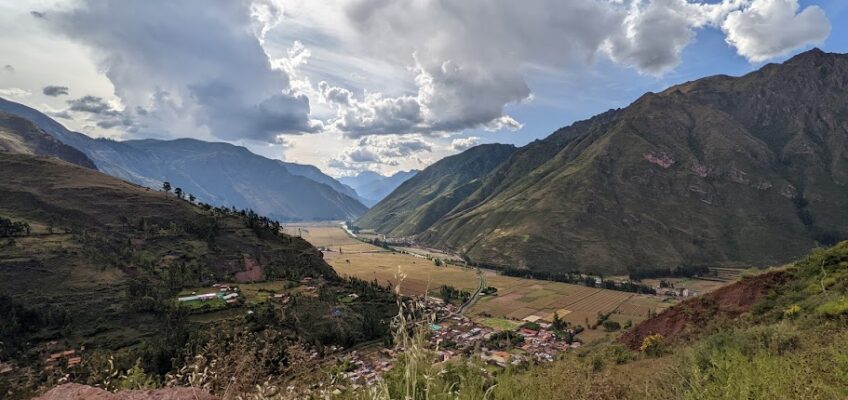I didn’t think I’d be able to blog while staying in Urubamba, but I found the one spot where there is strong and reliable WiFi, so here’s a quick recap of the last two days in the Sacred Valley
Wednesday
We arrived in Cusco on Wednesday morning. On the way out of the city we stopped at a viewpoint. (We’ll spend two nights in Cusco after we come back from Machu Picchu, so I’ll write about it then.) Then we visited a place where native women do weaving with wool from alpaca, llama, vicuña, and guanaco. It was interesting to watch their processes, especially the way they dye the yarn using all natural dyes. But it was also expensive — some of their work was so beautiful, and of course there was an opportunity to shop at the end of the demonstration. I bought a beautiful table runner made from baby alpaca wool.
We also got to feed the camelids.
Our next stop was a beautiful viewpoint overlooking the Sacred Valley. It’s called the Sacred Valley because it contains some of the most fertile land in the region. It was also not actually part of the Incan Empire, but rather the property of the emperor, Inca himself. The photo at the top of this post doesn’t quite do it justice.
Coca
Before heading to our hotel, we paid a visit to a family (husband, wife, and teenage daughter) who make their living by farming and selling coca. They showed us how they plant the seeds, care for the plants, harvest coca leaves, and prepare them to sell (as leaves, tea, liquor, and flour). They are expected to sell all their product to the official, government-run agency that produces coca candies and teas and other products. But because the government pays them so little, they can make much more money selling it privately, to tourists and to locals. In order to do that, they have to smuggle it from their farm back to town, about two hours by bus, and they showed us how they do that by hiding it under their clothes.
None of this has anything to do with cocaine. Yes, there are huge farms that grow mass quantities for cocaine production, but this family and others like them are subsistence farmers. Their coca is used for spiritual and medicinal purposes. It helps with altitude sickness and a host of other ailment.
Still, the risk to families like these is that the US government doesn’t care about the distinction. In the War on Drugs, these families are in danger of losing everything.
And it’s not just the loss of their livelihood that is at risk. Coca is part of the way of life in the Sacred Valley. If more US citizens learn about this, perhaps things will change. These people should be allowed to grow and use coca and preserve their culture and traditions.
Finally we arrived at our hotel, just in time for dinner and sleep.
Thursday
Chicha
Our first stop this morning was at a bar, and our first activity was to learn “Frogs,” a game involving tossing large coins into a contraption with various holes. The object was to get it in the frog’s mouth, nearly impossible.
Then we met the owner of the bar, who explained the production of chicha, a corn beer, and we got to taste it.
Santuario del Señor de Torrechayoc
Next we visited this church, the main church in Urubamba. The Lord of Torrechayoc is the town’s patron saint. Henry shared with us a legend about the church’s founding, where two brothers had the same dream under a tree that took on the shape of a cross. Their dream was to bring the cross to the church in town, but as they walked, the cross got heavier and heavier until they could carry it no farther. So they built a new church at the spot where they had to stop.
Here’s a somewhat more plausible story:
The veneration for the Lord of Torrechayoc most probably dates back to the 1860s. For the inauguration of a new section of the road connecting Urubamba and Lares, a group of devout Christians set up a cross in the snowy mountain area. In the following years, people passing by the cross claimed to have heard voices around the cross. The Lord was telling them how he suffered in the extreme cold of that place.
One day the parish priest of the nearest community ordered to move the cross to Urubamba, where the Lord of Torrechayoc achieved such fame that he became the patron saint of the province.
LimaEasy.com
Mercado
And I’ve run out of time this morning. Our next activity starts in five minutes, and then we head to Machu Picchu. I’ll try to add a “Part Two” to my Sacred Valley recap before i start writing about Machu Picchu.
Remind me to pick it up with “Mercado.”


Leave a Reply